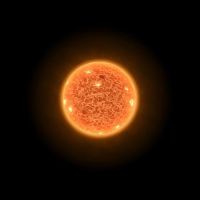Yurat (world)
| Yurat/Sithula (Divide 3204) | |||||||||||||||||||||||||
| Classic Era (1116) | ?324???-?
| ||||||||||||||||||||||||
| See also | UWP | ||||||||||||||||||||||||
| System Details | |||||||||||||||||||||||||
| Primary | M2 V | ||||||||||||||||||||||||
| Planetoid Belts | 0 | ||||||||||||||||||||||||
| Gas Giants | 0 | ||||||||||||||||||||||||
Yurat does not meet the criteria for any standard classification.
- This world is a "Twilight Zone World", a planet that is tidally-locked to its star. It has a hot side that permanently faces the star, a cold side that permanently faces away, and a narrow twilight zone in-between.
- It is an unclaimed Non-Aligned world located in the Sithula Subsector of Divide Sector.
Astrography and Planetology[edit]
This star system is detailed using the Fringian Variant System Description.
- It forms a part of the Glitterdrift Reach.
System Data[edit]
Orsa-Yurat System[edit]
The primary is Orsa, an ordinary red main sequence star. It has a luminosity of 0.0268 Sols, a mass of 0.4258 Sols, and a diameter of 658,000 km. (I) Yurat orbits within the habitable zone and is designated the mainworld. (II) a trace atmosphere hospitable world, (III) an exotic atmosphere stormworld, (IV) an exotic atmosphere bigworld, and (V) a trace atmosphere iceworld form the outer system. Many of the worlds retain satellites.
Mainworld Data[edit]
(I) Yurat[edit]
(I) Yurat is designated the mainworld. It orbits Orsa at a mean distance of 0.17 AU (25.4 million km), within the habitable zone. It has an orbital period of 39 days 6 hours: it is tidally locked to Orsa. The axial tilt is 5 degrees. Yurat has a diameter of 4,250 km, a density of 3.84 g/cm³, and a surface gravity of 0.23 G. The world is geologically inert. Its atmosphere is rated as Very Thin, Tainted, with a mean surface pressure of 0.19 bar and a composition of 90% nitrogen (N2), 8% abiotic oxygen (O2), 1% carbon dioxide (CO2), and 1% argon (Ar), water vapor (H2O), neon (Ne) and other trace gases. The taint is caused by the low percentage of atmospheric oxygen and large amounts of airborne silicates and dust. Approximately 42% of the surface is covered in seas of liquid water: average tidal ranges exceed 0.3m. Mean surface temperature: 11°C. The atmosphere is sluggish and weak weather systems driven by the star and the seas drift across the globe. The climate is static.
Mainworld Geography and Topography[edit]
Total surface area: 57 million km², Land surface area: 33 million km², Water surface area: 24 million km².
- The oxygen in the atmosphere is abiotic in origin, produced by the photocatalytic reaction between the high levels of UV energy radiating from the star and titanium dioxide (TiO2), which is found in surface minerals such as ilmenite.
Native Lifeforms[edit]
No world in the Yurat system is known to have native life.
History & Background (Dossier)[edit]
The Yurat system has been studied by the Local Astrographical Survey Project, a part of the Astronomy Department of the University of Selasia.
World starport[edit]
Yurat has no listed Starport data.
World technology level[edit]
Yurat has no listed Technology Level data.
World government[edit]
Yurat has no listed Government data.
World military[edit]
No information yet available.
World economy[edit]
No information yet available.
Trade data[edit]
No information yet available.
World demographics[edit]
Yurat has no listed Population data.
World culture[edit]
No information yet available.
Historical data[edit]
No information yet available.
World timeline[edit]
No information yet available.
UWP listing[edit]
No information yet available.
References & Contributors / Sources[edit]
| This article is missing content for one or more detailed sections. Additional details are required to complete the article. You can help the Traveller Wiki by expanding it. |
- Author & Contributor: Lord (Marquis) and Master Scout Emeritus Adie Alegoric Stewart of the IISS
- Author & Contributor: Lord (Marquis) and Master of Sophontology Maksim-Smelchak of the Ministry of Science
- ↑ "Jump Map API" and map location from Travellermap.com
